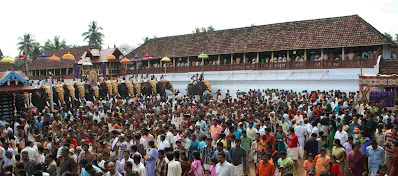 |
| Poornathrayeesa temple, Keralaen.wikipedia.org |
Above image: In the last two yeras, the temple festivals are low-key affairs on account of COVID -19.
 |
| Poornathrayeesa temple, Kerala uasatish.com |
Sree Poornathrayesa temple of Tripunithura, Kochi is a popular Hindu temple in Kerala state and it has the unique distinction of being the first among eight royal temples of the erstwhile Kochi Kingdom. Lord Vishnu, the primary god of this temple is the tutelary deity of the Royal family of Kochi. In this temple he is in the form of Santhanagopala and often known as Poornathrayeesa meaning fond of elephants.
 |
| .Poornathrayeesa temple, Kerala youtube.com/watch?v=U8ygpraGID4 |
In the famous annual festival or utchavam of this temple the Vrishchikoltsawam, it is said, more than 40 elephants actively participate. Celebrated in the month of Vrishchikam (November–December) lots of elephants are sent by owners free of fees to participate in the temple festival. A 8-day festival, events take place day and night for 7 days and they include Ottan Thullal, Kathakali, thayambaka, Chenda melam, katcheri, maddala ppattu, kombu pattu, and kuzhal pattu, etc all are native to Kerala. .
As the god happens to be the guardian deity of the ex ruling class of Kochi, extra significance is given to this famous festival which is said to be the biggest in the world, followed by Koodalmanikyam ulsavam of Iringalakkuda. What about Thrissur poorum? it is not a temple festival.
 |
| .Poornathrayeesa temple, Kerala pilgrimaide.com |
Tradition has been that as the presiding deity is Santhna Gopala Krishna, if childless couples visit the temple and pray to the deity with trust and devotion, they will be blessed with a child. This reminds me of the famous Mannargudi Rajagopala Swamy temple, in Thruvarur district of Tamil Nadu. Here childless couples are advised by the priests (Bhattacharyas) to carry the small idol of Santhana Gopla Krishnan in their hand jointly. The Ithegam is the God will bless them with a baby.
The legend has it the idol of Poornathrayeesa was given to Arjnuna (one of Pandava brothes of the Mahabharata) by God Vishnu. Because of Arjuna's association with this temple, the Srikovil/garbagriha has a unique shape - in the form of a chariot. Arjuna used the mustard seeds from the plants grown in the surrounding forest to get oil for lamps. A Valia Vilakku is in front of the idol and the burnt oil of this lamp has medicinal properties according to a local belief.
The moolavar (original idol) was originally in near-by Poonithura Sree Krishna Temple, . and the then ruler shifted the deity from there to the present location for unknown reason. The original design of this temple was according to native design and in 1920 a major fire mishap ravaged much of the temple, particularly the sanctum/ Srikovil mostly made of wood.
The temple was rebuilt in concrete, a departure from traditional method. The architect was one Sri Eachara Warrier, quite popular in this part. To make it look like a traditional design the temple was carefully covered with copper plates, wooden panels and granite tiles. The walls of srikovil are covered with large brass sheets with images of gods and goddesses; the roof is laid with copper sheets. A note worthy feature that is rare in many temples of Kerala and other parts of south India is the entrance to the sanctum which is covered with gold sheets. This temple with two-story gouram has a mantap supported by eight carved wooden pillars.
As for temple festivals there are many interesting ones. Mention may be made of Ambalam Kathi Utsavam (Thulam month) to recall the mire accident that took place in the past. After the evening deeparadhana, before lots of devotees a lump of camphor is lit all over the temple Besides Vrishchikolsavam, other festivities are he birthday of Sree Poornathrayeesha in "Uthram" Nakshathra of the Malayalam month Kumbham (February–March), Para Utsavam, where people give special offerings to the temple, Mooshari Utsavam (Aug. Sept.), Lakshmi Naryana Vilakku, Uthram Vilakku and Thulam Ombath Utsavam.
https://en.wikipedia.org/wiki/Sree_Poornathrayeesa_Temple









